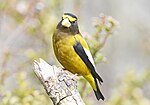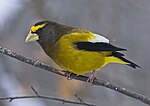The evening grosbeak (Hesperiphona vespertina) is a passerine bird in the finch family Fringillidae found in North America.
The evening grosbeak is bulky, with a large bill and short tail, is placed in the genus Hesperiphona by the IOC checklist and the Handbook of the Birds of the World, while the Clements Checklist and the AOS checklist place it in the genus Coccothraustes. Introduced by Charles Lucien Bonaparte in 1850, the genus Hesperiphona originates from Latin and Ancient Greek words meaning "evening" and "cry." The bird has a distinct appearance, with the adult male featuring a bright yellow forehead and body, brown head, and white wing patches, while the adult female has a mainly olive-brown body with greyer underparts and white wing patches.
The evening grosbeak breeds in coniferous and mixed forests across Canada, the western mountainous areas of the United States, and Mexico. Its migration pattern is variable, sometimes reaching as far south as the southern U.S. in winters. These birds forage in trees and bushes, and their diet mainly consists of seeds, berries, and insects. The bird's range has expanded eastward in historical times, likely due to the planting of Manitoba maples and other shrubs near farms and the availability of bird feeders during winter.
Taxonomy
The evening grosbeak was formally described in 1825 by the American naturalist William Cooper and given the binomial name Fringilla vespertina. Cooper had been sent a specimen by the ethnologist Henry Schoolcraft that had been collected in the evening near Sault Ste. Marie, Michigan. Cooper recorded the name of the bird in the Ojibwe language as "Paushkundamo".[2][3]
The IOC checklist and the Handbook of the Birds of the World place the evening grosbeak and the closely related hooded grosbeak in the genus Hesperiphona.[4][5] However, the Clements Checklist and the AOS checklist place the evening and hooded grosbeaks in the genus Coccothraustes with the hawfinch.[6][7]
The genus Hesperiphona was introduced by Charles Lucien Bonaparte in 1850.[8] The name is from Ancient Greek hesperos meaning "evening" and phōnē meaning "sound" or "cry". The specific epithet is from Latin vespertinus meaning "of evening", "of twilight" or "crepuscular".[9]
Three subspecies are recognised:[4]
- H. v. vespertina (Cooper, W, 1825) – central, east Canada and northeast USA
- H. v. brooksi Grinnell, 1917 – west Canada and northwest USA
- H. v. montana Ridgway, 1874 – southwest USA to southwest Mexico
Description
The evening grosbeak is similar in appearance to the Eurasian hawfinch, both being bulky, heavily built finches with large bills and short tails. The evening grosbeak ranges in length from 16 to 22 cm (6.3 to 8.7 in) and spans 30 to 36 cm (12 to 14 in) across the wings.[10][11] In a large sampling of grosbeaks in Pennsylvania during winter, males weighed from 38.7 to 86.1 g (1.37 to 3.04 oz), with an average of 60 g (2.1 oz), while females weighed from 43.2 to 73.5 g (1.52 to 2.59 oz), with an average of 58.7 g (2.07 oz).[12] Among standard measurements, the wing chord is 10.45 to 11.6 cm (4.11 to 4.57 in), the tail is 6 to 6.95 cm (2.36 to 2.74 in), the bill is 1.6 to 2 cm (0.63 to 0.79 in) and the tarsus is 1.95 to 2.2 cm (0.77 to 0.87 in).[13] The adult has a short black tail, black wings and a large pale bill. The adult male has a bright yellow forehead and body; its head is brown and there is a large white patch in the wing. The adult female is mainly olive-brown, greyer on the underparts and with white patches in the wings. They also have a loud distinctive 'chew' call, similar to a glorified house sparrow.
Breeding and ecology
The breeding habitat is coniferous and mixed forest across Canada and the western mountainous areas of the United States and Mexico. It is an extremely rare vagrant to the British Isles, with just two records so far. The nest is built on a horizontal branch or in a fork of a tree.
The migration of this bird is variable; in some winters, it may wander as far south as the southern U.S.
These birds forage in trees and bushes, sometimes on the ground. They mainly eat seeds, berries, and insects. Outside of the nesting season they often feed in flocks. Sometimes, they will swallow fine gravel.
The range of this bird has expanded far to the east in historical times, possibly due to plantings of Manitoba maples and other maples and shrubs around farms and the availability of bird feeders in winter.
Gallery
-
Female evening grosbeak in Algonquin Provincial Park, Ontario, Canada
-
Male evening grosbeak in Truchas, New Mexico
-
Female in winter, Gatineau Park, Quebec, Canada
-
Group in Carson National Forest, New Mexico
-
Feeding on sunflower seeds
References
- ^ BirdLife International (2018). "Hesperiphona vespertina". IUCN Red List of Threatened Species. 2018: e.T22720702A131500502. doi:10.2305/IUCN.UK.2018-2.RLTS.T22720702A131500502.en. Retrieved 12 November 2021.
- ^ Cooper, William (1825). "Description of a new species of Grosbeak, inhabiting the northwestern territory of the United States". Annals of the Lyceum of Natural History of New York. 1 (2): 219–222 [220].
- ^ Paynter, Raymond A. Jr, ed. (1968). Check-List of Birds of the World. Vol. 14. Cambridge, Massachusetts: Museum of Comparative Zoology. p. 304.
- ^ a b Gill, Frank; Donsker, David; Rasmussen, Pamela, eds. (January 2023). "Finches, euphonias". IOC World Bird List Version 13.1. International Ornithologists' Union. Retrieved 2 April 2023.
- ^ Clement, P. "Evening Grosbeak (Hesperiphona vespertina)". In del Hoyo, J.; Elliott, A.; Sargatal, J.; Christie, D.A.; de Juana, E. (eds.). Handbook of the Birds of the World Alive. Lynx Edicions. doi:10.2173/bow.evegro.01. S2CID 216413188. Retrieved 1 October 2016.(subscription required)
- ^ Clements, J.F.; Schulenberg, T.S.; Iliff, M.J.; Roberson, D.; Fredericks, T.A.; Sullivan, B.L.; Wood, C.L. (2016). "The eBird/Clements checklist of birds of the world: v2016". The Cornell Lab of Ornithology. Retrieved 11 August 2016.
- ^ "South American Classification Committee".
- ^ Bonaparte, Charles Lucien (1850). "Sur plusieurs genres nouveaux de Passereaux" [On several new genera of Passerines]. Comptes rendus hebdomadaires des séances de l'Académie des sciences (in French). 31: 424.
- ^ Jobling, James A. (2010). The Helm Dictionary of Scientific Bird Names. London: Christopher Helm. pp. 190, 400. ISBN 978-1-4081-2501-4.
- ^ "Evening grosbeak". All About Birds. Cornell Lab of Ornithology.
- ^ "Evening grosbeak". Guide to North American Birds. National Audubon Society. Archived from the original on 2013-03-04. Retrieved 2012-08-31.
- ^ Dunning, John B. Jr., ed. (1992). CRC Handbook of Avian Body Masses. CRC Press. ISBN 978-0-8493-4258-5.
- ^ Clement, Peter (1999). Finches and Sparrows. Princeton University Press. ISBN 978-0691048789.
External links
- Evening Grosbeak - Coccothraustes vespertinus - USGS Patuxent Bird Identification InfoCenter
- BirdLife species factsheet for Coccothraustes vespertinus
- "Hesperiphona vespertina". Avibase.
- "Evening grosbeak media". Internet Bird Collection.
- Evening grosbeak photo gallery at VIREO (Drexel University)
- Evening grosbeak species account at Neotropical Birds (Cornell Lab of Ornithology)
- Interactive range map of Coccothraustes vespertinus at IUCN Red List maps
- Audio recordings of Evening grosbeak on Xeno-canto.
- Hesperiphona vespertina in Field Guide: Birds of the World on Flickr
- Evening grosbeak media from ARKive
|
Help
|
|
Browse
|
Search
|
There is a page named "Evening Grosbeak" on this wiki
- Commons Attribution-Share Alike 4.0 truetrue English Evening Grosbeak British English Evening Grosbeak author name string: Vickie J Anderson Wikimedia username:...(3,403 × 2,390 (2.91 MB)) - 11:08, 9 February 2024
- kanadském Québecu (Réserve nationale de faune du cap Tourmente) English: Evening Grosbeak (Hesperiphona vespertina), Cap Tourmente National Wildlife Area, Quebec...(3,072 × 2,048 (2.15 MB)) - 18:59, 30 October 2022
- 4.0 Creative Commons Attribution-Share Alike 4.0 truetrue English Evening Grosbeak author name string: Vickie J Anderson Wikimedia username: VJAnderson...(3,101 × 2,111 (2.86 MB)) - 11:18, 9 February 2024
- 4.0 Creative Commons Attribution-Share Alike 4.0 truetrue English Evening Grosbeak author name string: Vickie J Anderson Wikimedia username: VJAnderson...(2,629 × 1,848 (2.45 MB)) - 11:19, 9 February 2024
- 4.0 Creative Commons Attribution-Share Alike 4.0 truetrue English Evening Grosbeak author name string: Vickie J Anderson Wikimedia username: VJAnderson...(3,452 × 2,523 (2.85 MB)) - 11:19, 9 February 2024
- 4.0 Creative Commons Attribution-Share Alike 4.0 truetrue English Evening Grosbeak author name string: Vickie J Anderson Wikimedia username: VJAnderson...(3,619 × 2,452 (3.26 MB)) - 11:08, 9 February 2024
- 4.0 Creative Commons Attribution-Share Alike 4.0 truetrue English Evening Grosbeak author name string: Vickie J Anderson Wikimedia username: VJAnderson...(2,325 × 1,626 (2.4 MB)) - 11:18, 9 February 2024
- 4.0 Creative Commons Attribution-Share Alike 4.0 truetrue English Evening Grosbeak author name string: Vickie J Anderson Wikimedia username: VJAnderson...(2,913 × 1,866 (3.74 MB)) - 11:18, 9 February 2024
- 4.0 Creative Commons Attribution-Share Alike 4.0 truetrue English Evening Grosbeak above Sylvan water in Green-wood cemetery, Brooklyn, NY author name...(1,761 × 991 (697 KB)) - 09:25, 19 June 2023
- 4.0 Creative Commons Attribution-Share Alike 4.0 truetrue English Evening Grosbeak object has role: photographer author name string: George Murre Wikimedia...(2,243 × 1,588 (2.34 MB)) - 02:04, 24 January 2024
- 4.0 Creative Commons Attribution-Share Alike 4.0 truetrue English Evening Grosbeaks author name string: Vickie J Anderson Wikimedia username: VJAnderson...(2,012 × 1,419 (1.95 MB)) - 11:19, 9 February 2024
- DescriptionEvening grosbeak.jpg English: At Crater Lake National Park Date 16 July 2021, 15:12:00 Source https://www.flickr.com/photos/132545975@N04/51373322884/...(3,545 × 2,363 (1.15 MB)) - 20:03, 4 July 2023
- Category:Hesperiphona vespertina (redirect from Evening Grosbeak)category] [edit wikidata 'Evening Grosbeak' main topic of 'Category:Hesperiphona vespertina'] English: Evening Grosbeak asturianu: Coccothraustes vespertinus...193 members (5 subcategories, 187 files) - 06:20, 17 December 2019
- DescriptionEvening grosbeak - 51373322789.jpg English: At Crater Lake National Park Date 16 July 2021, 15:12:06 Source https://www.flickr...(3,302 × 2,201 (866 KB)) - 20:03, 4 July 2023
- vespertinus (W. Cooper, 1825) Vernacular names [edit wikidata 'Evening Grosbeak'] English: Evening Grosbeak asturianu: Coccothraustes vespertinus Atikamekw: Tcari...2 KB (243 words) - 12:18, 13 December 2021
- Creative Commons Attribution-Share Alike 4.0 truetrue English Female evening grosbeak (Hesperiphona vespertina) in Algonquin Park author name string: Mykola...(3,051 × 2,317 (4.43 MB)) - 06:36, 24 January 2024
- DescriptionEvening grosbeak (53467665336).jpg We spotted this male evening grosbeak in a snowy red pine tree in Minnesota. Photo by Courtney Celley/USFWS...(3,200 × 2,133 (3.44 MB)) - 19:31, 16 May 2024
- DescriptionEvening grosbeak (53468087740).jpg We spotted this male evening grosbeak in a snowy red pine tree in Minnesota. Photo by Courtney Celley/USFWS...(5,600 × 3,733 (9.6 MB)) - 19:31, 16 May 2024
- DescriptionReed-evening-grosbeak.png Evening Grosbeak. Date 1915 Source Chester A. Reed, The Bird Book, 1915. Received from http://www.gutenberg.org/etext/30000...(240 × 319 (60 KB)) - 06:29, 12 July 2024
- Creative Commons Attribution-Share Alike 4.0 truetrue English Male evening grosbeak (Hesperiphona vespertina) in Algonquin Park author name string: Mykola...(3,424 × 2,422 (4.67 MB)) - 06:36, 24 January 2024























Recent Comments